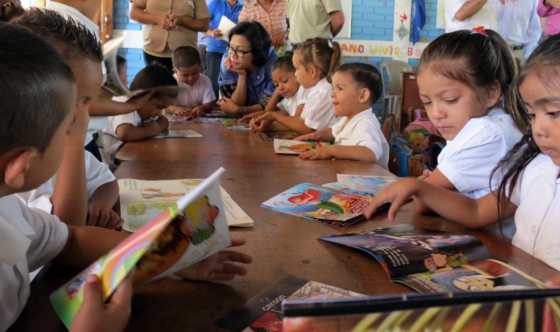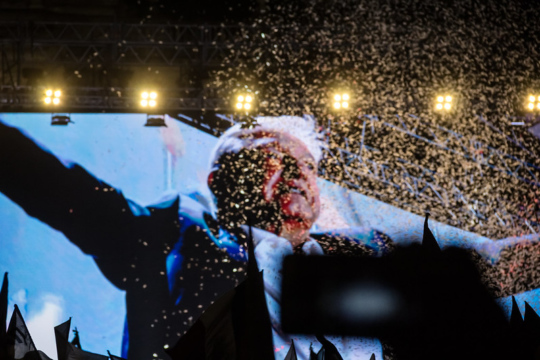This post is also available in:
Spanish
At the Inter-American Dialogue and Teach For All, we believe that this is a critical time for education in Latin America and the Caribbean. After consulting with different educational stakeholders from the public and private sectors about the impact of the Covid-19 pandemic on the educational systems of the region, we are pleased to share a brief analysis of the responses we received. Our aim is to understand the thinking behind efforts related to the delivery of education services, as well as what education systems are doing to ensure students continue learning.
At the institutional level, the responses from the Ministries of Education have been highly diverse in terms of the level of organization, comprehensiveness and capacity to mobilize actors beyond the Ministries themselves. In some cases, the Ministries of Education have organized high-level committees, working groups, and commissions to design plans and discuss actions and proposals in response to the crisis. Although several of these committees include non-governmental organizations, funders and cooperation agencies, the ongoing challenge for these committees and working groups has been the need to consider a technological response to continue providing distance education. In some cases, official responses have sought to integrate different approaches (distance learning programs, teacher training, support to students from vulnerable backgrounds), while in others, responses have so far been more targeted. Additionally, some countries have organized multi-sectoral alliances and campaigns with the participation of civil society to disseminate and accompany ministerial responses.
Peru and Nicaragua offer two contrasting examples of how Ministries are responding to the crisis. In the case of the Ministry of Education (MINEDU) in Peru, the national leadership came together to establish a Covid-19 commission within the MINEDU. Likewise, within the Planning Secretariat, specific roles were assigned to coordinate efforts with civil society and the private sector. The MINEDU also convened roundtables tables with civil society organizations to rethink the school year and the role of educators. The “Aprendo En Casa” national campaign was quickly designed and launched, consisting of an interactive, online learning platform, as well as TV and radio lessons for students in remote areas. In order to enhance learning, MINEDU established partnerships with organizations that already had distance education curricula available (such as Khan Academy) to be included on the “Aprendo en Casa” portal. In order to increase student access to this content, the MINEDU is also in the process of purchasing around 800,000 tablets with permanent internet connections to distribute in remote areas where connectivity is lacking. Beginning in April, academic content is offered to students on television and radio stations. Additionally, the MINEDU has set up another educational program to reach out to 15,000 families, involving over 1,000 volunteers from civil society organizations, and in close coordination with the Ministry of Social Inclusion, to bring the “Qali Warma” supplemental nutrition program to rural areas.
In Nicaragua, the Ministry of Education (MINED) did not close schools, and regular classes have continued. Emergency committees have not been convened nor other actors been called upon. To date, the only response has been a campaign to increase hand washing and a set of potential actions in case the crisis were to worsen significantly. Amongst these possible actions are online education, delivery of printed workbooks, and the use of TV. The remote education strategy supposes a series of guidelines emanating from the central government to educational centers. Despite public schools remaining open, there has still been an educational impact: around 70 percent of private schools have closed and only 60 percent of public school students continue to attend in-person classes.
Resurgence of television (TV) and radio as strategies to keep students learning. Countries are using a wide array of tools to enable distance education, with TV and radio being the main channels. Several countries have implemented programs supported by local non-governmental organizations to train teachers in the use of available platforms and materials in this new context. These same organizations are also developing content and strategies for radio and TV programs to support the ministries’ efforts. Despite the advances in TV, radio and virtual education—including learning platforms and information and communication portals—the limited access to communication technologies and low levels of connectivity continue to hinder equal learning opportunities for all students.
Most teachers continue working virtually, on both professional development and to support students, but face significant challenges. Even though countries have designed training sessions for tech management and have enhanced their courses on academic and socio-emotional content, the crisis has highlighted the gap in the use of technologies and the difficulties ministries face in securing high quality trainings and flexible content delivery. The support of non-governmental organizations has proven useful in the design and delivery of these trainings in countries where ministries have expressed the need for such support during the crisis. Even as teachers find innovative ways to reach students via phone, email, and other portals, not all teachers have access to the necessary technology or have the basic conditions at home to teach virtually—nor do all students have internet access or mobile phones.
School reopening is still uncertain. There is uncertainty around the contingency plans for a possible wave of new infections in the second half of 2020, and actions around reopening schools have been different between the northern and southern hemispheres. In countries in the northern hemisphere where the school year was already well underway, it is unlikely that schools will reopen, with some countries already issuing an official announcement. For example, the Dominican Republic has decided to continue distance education through the end of the school year on June 19. In El Salvador, the school year will continue under different distance education modalities: online, printed study guides for students without access to the internet, and, once materials are prepared, radio and TV lessons. Mexico plans to continue distance education strategies through the end of July, beginning classes for the upcoming school year in August or September depending on the education level. The original goal was for all schools to reopen by June 1 and close the 2019-2020 school year on July 17, only a few weeks later than scheduled.
In the southern hemisphere, where school closures overlapped with the beginning of the school year, the landscape is not so clear. In Argentina, there is no official response. Unofficially, the media speculates that schools will only reopen in September or October. Paraguay has declared that there will be no in-person classes until December 2020, and that learning will continue virtually until then. In Colombia, the reopening of schools has been pushed to the end of June, and in Panama until August or September.
2020 will not be a regular academic year. Reacting flexibly to adjust the curriculum and adapt it to the new normal has proven difficult. The Dominican Republic undertook a curricular revision involving all eighteen regional directorates in the country, and determined that 70 percent of the curriculum had already been taught (according to the time of the school year when the virus hit the country). It established a mandatory diagnostic test when students reenter school in the upcoming school year, and is currently designing recovery plans for different levels of expected results. In Chile, the Unit for Curriculum and Evaluation has prioritized the learning objectives by subject area, although on-the-ground experience suggests that teachers are not knowledgeable on the topic and tend to push through the content regardless of students’ cognitive baseline. Some countries (El Salvador, Guatemala) have announced an adjustment to the curriculum, although it is not clear how this will be handled, and there are no support or recovery plans as of yet. Other countries (Argentina, Panama, Paraguay) have not made any public announcements on the topic. In some cases, there are already conversations around credit recovery (and subsequent curriculum adjustments), but there are no examples of countries that have definitively made that decision. In countries where schools have curricular autonomy (Colombia, Argentina), it will be up to individual education centers to define whether they will make adjustments or not. What is indeed clear is that national learning evaluations will not happen in 2020. It is not as clear how evaluation of learning at the school level will happen.
Reinforcement of the idea that schools have a role in coordinating resources and support for the community, especially in school feeding programs. Throughout this crisis, countries have adopted different strategies at both the national and the local levels. At the national level, some countries have used the police, ministry personnel or local organizations to deliver food to schools and community centers. Locally, schools prepare the food they offer, and families have organized amongst themselves to ensure the delivery of food to students. Most countries reported continuity in their feeding programs.
The Inter-American Dialogue in partnership with Teach For All and other likeminded organizations in the region will continue to monitor the situation and exploring possible responses to guarantee a quality education for all students in the region. In our next edition, we will focus on capturing the voices of teachers amidst the pandemic.
We thank education stakeholders, non-governmental organizations, and other partners for their responses to our survey. Ana Florez is the regional director of Teach For All in the Americas.
RELATED RESOURCES
Covid-19 in the Americas: The Dialogue’s Coronavirus Updates
Early Childhood and Covid-19: Responses to the Emergency How to protect education outcomes in the face of the Covid-19 crisis?






















